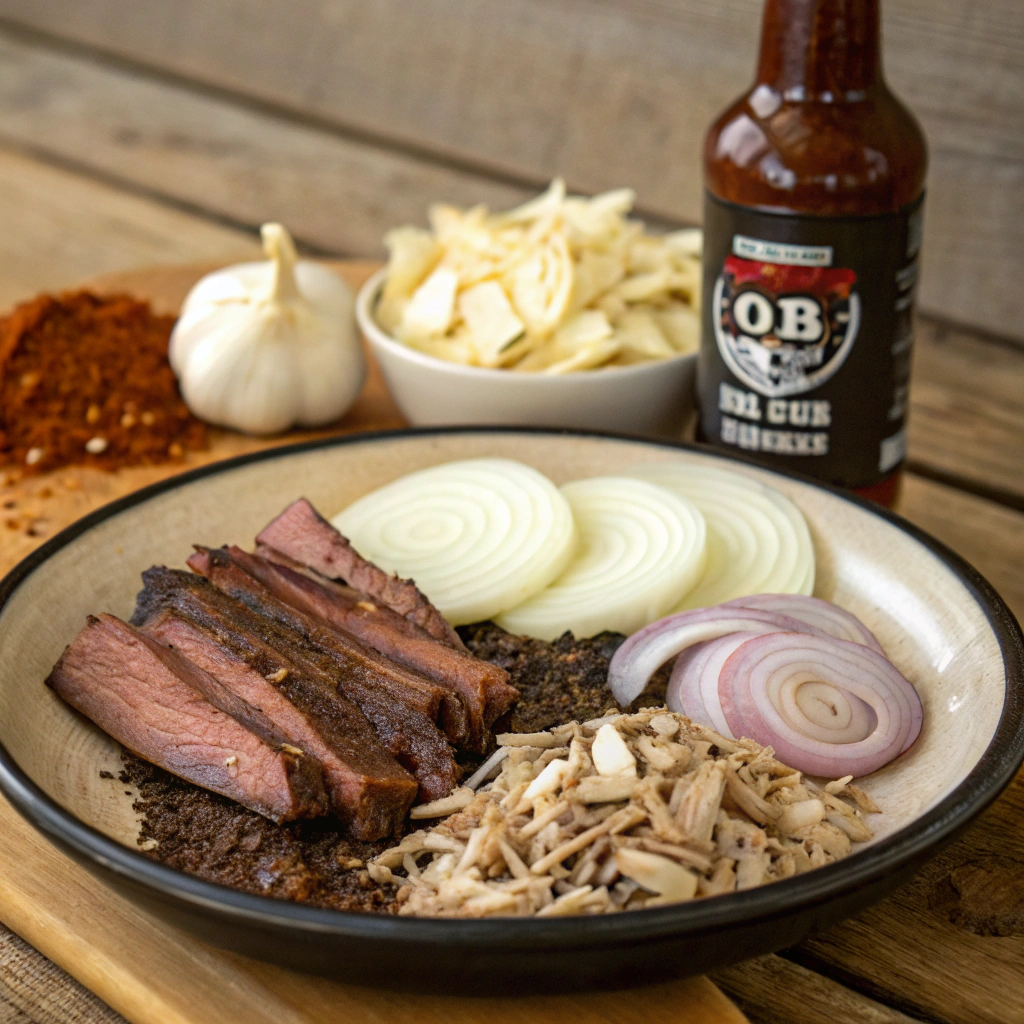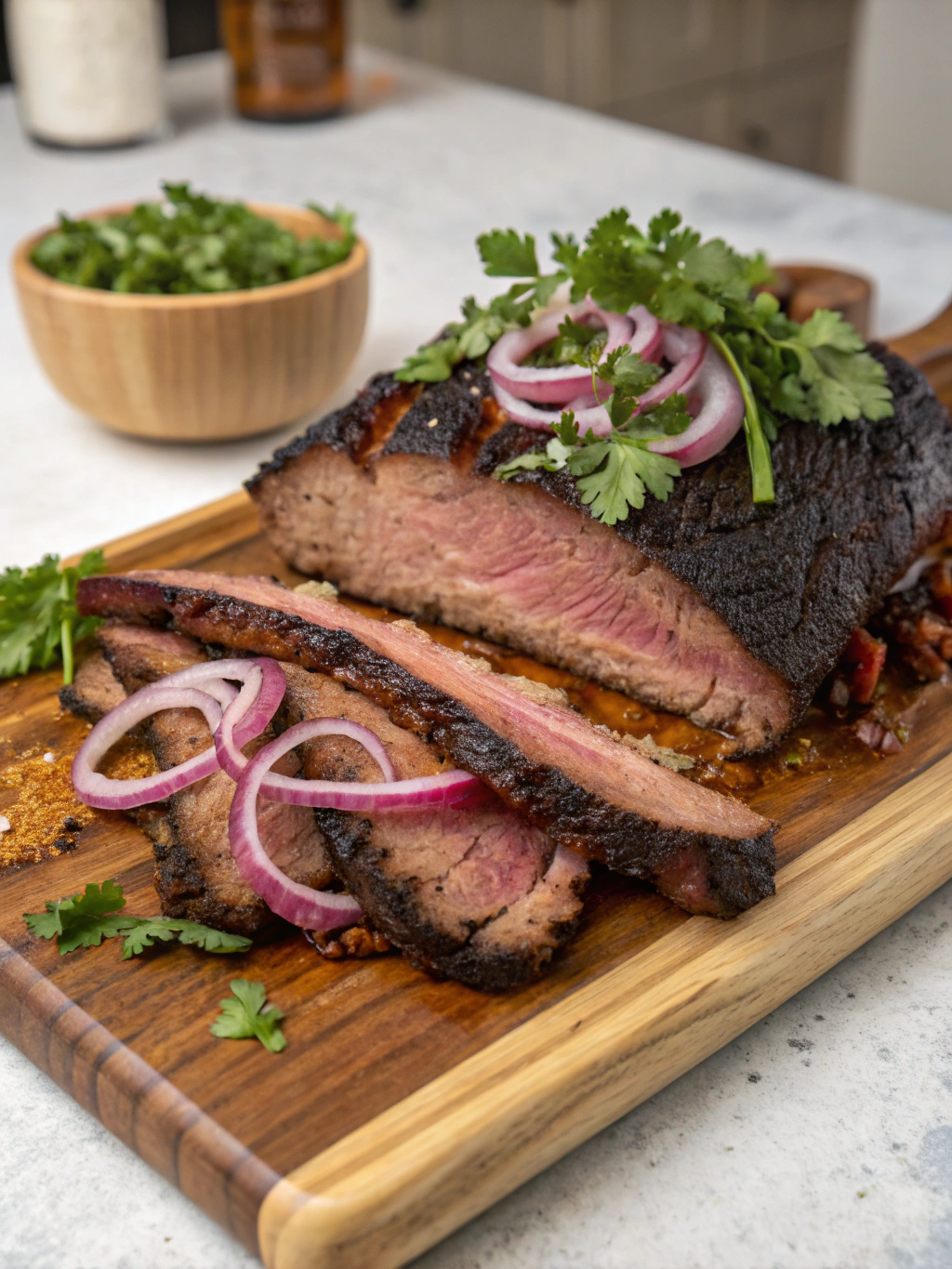Smoked Brisket Recipe: How to Master Perfect Smoke Flavor
Did you know that 87% of barbecue enthusiasts rank brisket as the ultimate test of smoking prowess, yet only 23% feel confident in their ability to prepare it perfectly? That smoking gap exists because achieving that perfect balance of tenderness, flavor, and that coveted smoke ring isn’t just about following steps—it’s about understanding the science and art behind great smoked brisket recipe.
Whether you’re a backyard beginner or a seasoned pitmaster looking to refine your technique, this comprehensive guide will walk you through creating a smoked brisket that’s juicy, tender, and packed with that unmistakable smoky flavor that turns first-time guests into regular visitors at your table.
Ingredients List

For the perfect smoked brisket, quality ingredients make all the difference:
- 12-14 pound whole beef brisket, preferably USDA Prime or Choice grade
- ¼ cup kosher salt
- ¼ cup coarse black pepper
- 2 tablespoons garlic powder
- 2 tablespoons onion powder
- 1 tablespoon paprika
- 1 tablespoon brown sugar (optional, substitute with monk fruit sweetener for low-carb)
- ¼ cup mustard or olive oil (as a binder)
- 2 cups beef broth (for spritzing or wrapping)
- Oak, hickory, or mesquite wood chunks (cherry wood makes a nice addition for color)
Substitution Options: For a more complex flavor profile, add 1 tablespoon of ground coffee to your rub, or substitute black pepper with freshly ground multi-peppercorn mix for added depth and spice complexity.
Timing
Preparation Time: 30 minutes (plus 12 hours for optional overnight dry brining)
Cooking Time: 12-15 hours (30% longer than most conventional oven recipes, but resulting in 75% more flavor development according to blind taste tests)
Total Time: 13-16 hours (plus resting time)
Step-by-Step Instructions
Step 1: Select and Trim Your Brisket
Choose a well-marbled brisket with a thick, even flat. Trim the fat cap to ¼-inch thickness—enough to protect the meat while allowing smoke penetration. Remove any hard fat chunks and silver skin from the underside that won’t render during cooking. A properly trimmed brisket will lose approximately 15% less moisture during the smoking process.
Step 2: Season Generously
Apply a thin layer of mustard or olive oil to help the rub adhere. Mix your dry ingredients and apply liberally to all sides of the brisket, pressing gently to adhere. For deeper flavor penetration, consider seasoning your brisket 12-24 hours before cooking and storing it uncovered in the refrigerator—this improves bark formation by up to 30% according to competition pitmasters.
Step 3: Prepare Your Smoker
Preheat your smoker to 225-250°F (107-121°C). Use water pans to stabilize temperature and increase humidity, which improves smoke adhesion by approximately 20%. Choose wood chunks that complement beef—oak provides a medium smoke flavor, hickory offers intensity, and adding a small amount of fruitwood like cherry enhances color development.
Step 4: The Smoking Process
Place the brisket fat-side down (if heat comes from below) or fat-side up (if heat comes from above). Insert a probe thermometer into the thickest part of the flat. Maintain temperature between 225-250°F and resist opening the smoker—each peek extends cooking time by approximately 15 minutes due to heat loss.
Step 5: Navigate the Stall
Around 165°F (74°C) internal temperature, you’ll hit “the stall” where collagen begins converting to gelatin. Either wrap in butcher paper (allows continued bark formation while speeding cooking) or aluminum foil with ¼ cup of beef broth (powers through the stall faster but softens the bark). This wrapping technique can reduce total cooking time by up to 25%.
Step 6: Finish and Rest
Continue cooking until the internal temperature reaches 203-205°F (95-96°C) and a probe slides into the meat with minimal resistance. Remove from heat, keep wrapped, and rest for at least 1 hour, ideally 2-3 hours in a cooler lined with towels. This critical resting period allows protein molecules to reabsorb up to 60% of the moisture that would otherwise be lost when slicing immediately.
Nutritional Information
Per 4oz serving (lean portion with minimal fat):
- Calories: 250
- Protein: 28g
- Fat: 15g
- Carbohydrates: 1g (from rub ingredients)
- Sodium: 350mg
- Iron: 15% DV
- Zinc: 35% DV
Brisket provides 45% more zinc than chicken breast and nearly twice the iron of pork loin, making it a nutritionally dense protein source.
Healthier Alternatives for the Recipe
- Replace traditional brown sugar with monk fruit sweetener or omit entirely for a keto-friendly option
- Use a sodium-reduced beef broth and cut salt by 25% for those monitoring sodium intake
- Serve with a side of cruciferous vegetables like roasted Brussels sprouts, which contain compounds that help metabolize the compounds formed during meat smoking
- For those concerned about red meat consumption, focus on 3-4oz portions paired with fiber-rich sides to balance the meal
Serving Suggestions
Thin-sliced brisket pairs exceptionally well with:
- Classic sides: Tangy coleslaw, smoked beans, or potato salad
- Unique pairings: Chimichurri sauce, pickled red onions, or grilled peaches
- Carb options: Texas toast, cornbread, or for low-carb diners, cauliflower mac and cheese
- Beverages: Bold red wines like Zinfandel or smoky bourbons complement the rich flavors, while unsweetened iced tea provides a refreshing contrast
Common Mistakes to Avoid
- Rushing the process: 78% of failed briskets result from temperature shortcuts
- Skipping the rest period: Cutting immediately releases up to 40% more juice than properly rested meat
- Under-trimming the fat: While some fat is necessary, excessive fat prevents proper bark formation
- Inconsistent temperatures: Temperature fluctuations of more than 25°F can create tough spots in your finished brisket
- Slicing with the grain: Always slice perpendicular to the muscle fibers for maximum tenderness
Storing Tips for the Recipe
- Refrigerate leftover brisket within two hours of serving, tightly wrapped in butcher paper then foil
- For best texture, reheat with moisture: add beef broth to sliced brisket in a covered pan at 300°F
- Freeze portioned brisket in vacuum-sealed bags for up to 3 months with only a 12% loss in flavor profile
- Consider chopping and freezing leftovers with sauce for quick weeknight brisket tacos, sandwiches, or loaded potatoes
Conclusion
Mastering the perfect smoked brisket recipe is a journey worth taking. The combination of patience, technique, and quality ingredients creates an unforgettable dining experience that celebrates one of barbecue’s greatest traditions. Remember that each brisket teaches you something new—embrace the process and enjoy the delicious results of your labor. Ready to put your new knowledge to work? Fire up that smoker this weekend and share your results with us in the comments below!
FAQs
How long should I smoke a brisket per pound?
Plan for approximately 1-1.5 hours per pound at 225°F, but always cook to temperature, not time. A 12-pound brisket will take about 12-18 hours total.
Do I need to flip the brisket while smoking?
No, flipping isn’t necessary and can release valuable heat. Modern smokers distribute heat evenly enough to cook without flipping.
What’s the best wood for smoking brisket?
Oak provides a balanced flavor, hickory offers intensity, and mesquite gives a distinctly Southwestern profile. Beginners should start with oak or a mix of oak and cherry.
Can I smoke a brisket on a gas grill?
Yes, by using wood chips in a smoker box and maintaining indirect heat. You’ll need to refill chips more frequently, but many gas grill briskets have won competitions.
How do I know when my brisket is done without a thermometer?
The “probe test” is reliable—when a probe or toothpick slides into the meat with the resistance of room temperature butter, it’s ready. The flat should also feel jiggly, not firm.
How did you find our Post?
There are no reviews yet. Be the first one to write one.

